Paid advertising has revolutionized digital marketing, providing businesses with powerful tools to reach targeted audiences and drive measurable results. In today’s hyper-competitive digital landscape, understanding the intricacies of pay-per-click (PPC) and media buying strategies is no longer optional—it’s essential for businesses looking to maximize their online presence and generate meaningful ROI. Whether you’re a small startup or a large enterprise, the ability to effectively leverage paid advertising can mean the difference between blending into the background and standing out in a crowded marketplace.
Understanding the Fundamentals of Paid Advertising
Paid advertising represents a strategic approach to digital marketing where businesses pay to display advertisements across various online platforms. These platforms include search engines like Google, social media networks such as Facebook and LinkedIn, display networks, and programmatic advertising channels. The core principle is simple yet powerful: advertisers pay a fee each time their ad is clicked or viewed, allowing for precise targeting and immediate visibility.
The most common paid advertising models include cost-per-click (CPC), cost-per-thousand-impressions (CPM), and cost-per-action (CPA). Each model offers unique advantages depending on your marketing objectives. CPC is ideal for driving website traffic, CPM works well for brand awareness campaigns, and CPA focuses on specific conversions or actions. Successful paid advertising requires a deep understanding of these models and the ability to select the most appropriate approach for your specific business goals.
Developing a Strategic Paid Advertising Campaign
Creating a successful paid advertising campaign demands meticulous planning and strategic execution. The first step involves comprehensive audience research, where marketers develop detailed buyer personas that outline demographic information, interests, online behaviors, and potential pain points. This foundational research enables hyper-targeted ad creation that resonates deeply with specific audience segments.
Keyword research plays a crucial role in campaign development, particularly for search-based advertising. Utilizing tools like Google Keyword Planner, SEMrush, and Ahrefs allows marketers to identify high-value keywords with optimal search volume and competition levels. The goal is to find a balance between relevance, search intent, and cost-effectiveness. Advanced marketers often employ long-tail keywords that demonstrate more specific user intent and typically feature lower competition and cost.
Advanced Targeting and Audience Segmentation
Modern paid advertising platforms offer unprecedented targeting capabilities that go far beyond basic demographic information. Marketers can now create intricate audience segments based on behaviors, interests, previous interactions, and even predictive modeling. Platforms like Facebook Ads and Google Ads provide sophisticated targeting options including custom audiences, lookalike audiences, and retargeting mechanisms.
Retargeting represents a particularly powerful strategy, allowing advertisers to re-engage users who have previously interacted with their website or digital assets. By implementing pixel tracking and creating segmented remarketing lists, businesses can deliver highly personalized advertisements to users who have already demonstrated interest, significantly improving conversion potential and marketing efficiency.
Optimization and Performance Measurement
Successful paid advertising requires continuous optimization and rigorous performance tracking. Key performance indicators (KPIs) such as click-through rate (CTR), conversion rate, cost per acquisition, and return on ad spend provide critical insights into campaign effectiveness. Advanced marketers utilize A/B testing methodologies to systematically improve ad creative, targeting, and landing page designs.
Machine learning and artificial intelligence are increasingly being integrated into advertising platforms, offering automated bidding strategies and predictive performance insights. These technologies enable more sophisticated optimization techniques, allowing marketers to achieve better results with less manual intervention. However, human expertise remains crucial in interpreting data and making strategic decisions.
Budget Management and Cost Efficiency
Effective budget allocation is a critical component of successful paid advertising strategies. Marketers must balance aggressive growth objectives with financial prudence, carefully monitoring spending across different channels and campaigns. Many successful organizations implement a diversified approach, spreading budgets across multiple platforms to mitigate risk and maximize overall marketing performance.
Advanced budget management techniques include setting precise daily and lifetime budgets, implementing bid strategies aligned with specific objectives, and continuously reallocating resources based on performance data. The most sophisticated marketers develop comprehensive financial models that calculate customer lifetime value and align advertising investments accordingly.
Emerging Trends and Future Considerations
The paid advertising landscape continues to evolve rapidly, with emerging technologies and changing consumer behaviors driving innovation. Privacy regulations, increased user awareness, and platform-specific changes are compelling marketers to develop more transparent, value-driven advertising approaches. Successful practitioners will need to prioritize user experience, leverage first-party data, and develop more personalized, contextually relevant advertising strategies.
As artificial intelligence, machine learning, and advanced analytics continue to reshape the digital marketing ecosystem, paid advertising will become increasingly sophisticated. Marketers who invest in continuous learning, embrace technological innovations, and maintain a strategic, data-driven approach will be best positioned to succeed in this dynamic environment.
Mastering paid advertising requires a holistic approach that combines strategic thinking, technical expertise, and creative problem-solving. By understanding fundamental principles, leveraging advanced targeting capabilities, and maintaining a commitment to continuous optimization, businesses can transform paid advertising from a simple marketing tactic into a powerful growth engine. The future belongs to those who can effectively navigate complexity, deliver genuine value, and connect with audiences in meaningful, personalized ways.



 by
by